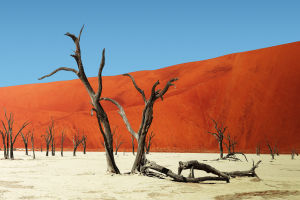Camels are very good at enduring hunger and thirst after one drink of water.
They can stop drinking for many days and still be active in hot, arid desert areas. Why are they able to do this?
For creatures living in deserts, securing water and reducing water loss are equally important.
Over a long period of evolution, camels have gradually developed a set of adaptive mechanisms, from structural to physiological, that are compatible with reducing water loss.
1. Delicate thermoregulation
Camels have a wide range of body temperatures, which is adapted to the desert environment with large temperature differences between day and night and the need to reduce water loss.
During the day, the body temperature of camels increases with the increase of ambient temperature, reaching a maximum of 41℃.
And then decreases with the decrease of ambient temperature at night, reaching a minimum of 34℃, with a fluctuation of 7℃, and this fluctuation is more obvious under dehydration.
In a high-temperature environment, increasing body temperature can reduce the magnitude of the temperature difference between the animal body and the environment and reduce the inflow of heat from outside.
At the same time, the increase in body temperature of camels also plays a role in storing heat, and this stored heat can be diffused to the surrounding environment at night by conduction and radiation instead of evaporation, thus reducing the evaporative water loss that may result from maintaining a constant body temperature.
2. Effective thermal barrier
The long and fluffy camel hair forms an effective heat insulation barrier on the surface of the camel's body.
The non-flowing layer of air between the camel hair affects conduction and convection, reducing the loss of body heat at low temperatures and the inflow of external heat at high temperatures.
In addition, the large nasal mucosa of camels increases the reabsorption of water in the exhaled gas and reduces respiratory water loss, concentrated urine reduces the consumption of water in excreted waste.
3. Hunger resistance
Despite the lack of vegetation and forage resources in the desert, camels are still hardy and adapt to their environment with their strong hunger tolerance, even after days and nights without grass and forage.
In summer and autumn, when grass and water are abundant, camels take large amounts of food, which is converted into fat and stored in the hump and abdominal cavity.
In winter and spring, when there is no grass, the fat stored in the hump and abdominal cavity becomes energy to support the body's activities.
The camel has evolved over time to adapt to the extreme water scarcity of the desert and has developed unique adaptive characteristics to ensure that it "stores" large amounts of water in its body and that it does not lose too much water, thus effectively solving the problem of "water", the most prominent problem facing desert animals.
This effectively solves the most prominent conflict facing the survival of desert animals, It is really a very special creature.


